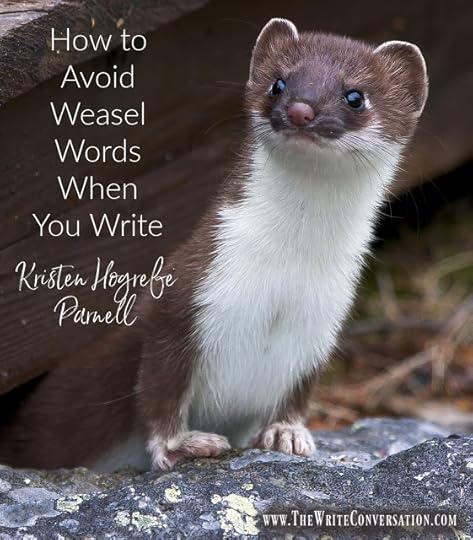How to Avoid Weasel Words When You Write

By Kristen Hogrefe Parnell @khogrefeparnell
By night, I write novels, and by day, I teach English online to ninth graders. One of my joys is when students realize my desire is not to be overly critical but to help them express themselves as clearly and effectively as possible. During one such session, a student thanked me for my detailed comments but said he didn’t understand why I highlighted certain words on his essay.
“Do you see how you’ve used the word ‘thing’ multiple times in this paragraph?” I asked. “Instead, try using more specific or descriptive words to say what you mean.”
“Oh, yeah, I guess I do tend to overuse that one.”
“It’s one of your weasel words, and we all have them,” I said. “The key is to be aware of them.”
“Weasel words,” he repeated. “Huh, I’ve never heard it put that way before, but it makes sense.”
Although we writers have long since graduated high school and college, we probably still have words that “weasel” their way into our writing more than they should. The good news is that there are simple solutions to this problem.
#1: Know what they are.
If you’ve been writing for any amount of time, you’ve probably noticed a pattern of pet words or phrases. Perhaps your character “gasps” every other page. At one point, my editor kindly pointed out that my heroine “rolled her eyes” so much that it made her unlikable.
These words can also be adverbs, like “really” and “very” that simply aren’t necessary, or adjectives that “tell” instead of letting the description or dialogue reveal the information organically.
Regardless of which weasel words reappear on your page, keep a running list of words you notice yourself overusing and save it somewhere so you can refer to it often.
#2: Forget about them.
This piece of advice seems to negate step one, but we can’t focus on our weasel words when writing our rough drafts. If we do, we will get lost in the mechanics and lose sight of the story or message we’re trying to tell.
When drafting, focus on story. We’ll have time to weed out the weasel words later.
#3: Edit them out.
Sometimes, “weasel words” can even be acceptable misspellings. For me, I tend to type “image” when I mean to say “imagine.” A spell check won’t catch this mistake, because both are correctly spelled words.
The good news is that you can easily edit out mistakes like this. If you write in Microsoft Word, here are some easy steps to follow:Under the Home tab, choose “Find” and then “Advanced Find.”Type in a word or phrase you might be overusing.Choose the “Reading Highlight” option. You should then see the option to “Highlight All.”Word will then tell you how many instances were highlighted.At a glance, you can see how often you’re using the weasel word per page or per chapter and then make revisions.To remove the highlighting, follow the previous steps and choose “Clear Highlighting.”Okay, I’ve confessed my weasel words. What are some of yours, and do you have any other tips for dealing with them?
TWEETABLEHow to Avoid Weasel Words When You Write - @khogrefeparnell on @EdieMelson (Click to Tweet)
 Kristen Hogrefe Parnell is an award-winning author and life-long learner. An educator and mentor, she teaches English online and is an inspirational speaker for schools, churches, and podcasts. Her young adult dystopian novels, The Revisionary and The Reactionary, both won the Selah for speculative fiction, and she is working on several new projects, including a romantic suspense novel. Kristen and her husband live in Florida and enjoy sharing their lake home with family and friends. She blogs at KristenHogrefeParnell.com where she challenges readers to find faith in life’s everyday adventures.
Kristen Hogrefe Parnell is an award-winning author and life-long learner. An educator and mentor, she teaches English online and is an inspirational speaker for schools, churches, and podcasts. Her young adult dystopian novels, The Revisionary and The Reactionary, both won the Selah for speculative fiction, and she is working on several new projects, including a romantic suspense novel. Kristen and her husband live in Florida and enjoy sharing their lake home with family and friends. She blogs at KristenHogrefeParnell.com where she challenges readers to find faith in life’s everyday adventures.
Published on April 04, 2021 22:00
No comments have been added yet.



